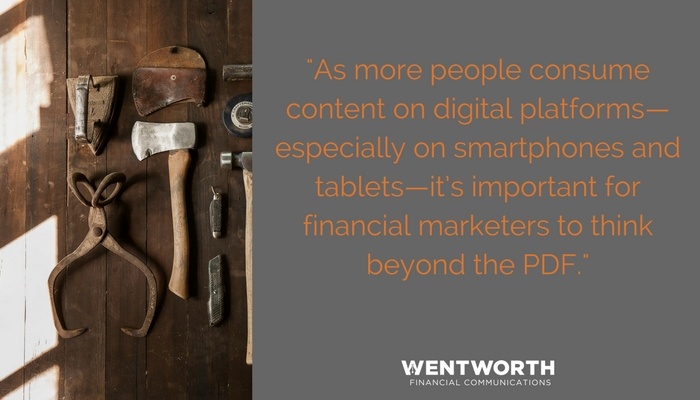There’s an old saying: “When all you have is a hammer, everything is a nail.” For many financial marketers, when it comes to creating thought-leadership content, PDFs are their trusty, old hammers. As a result, they think that PDFs are the only medium available for their white papers, articles, and other long-form content.
To be sure, PDFs are still effective tools for conveying long-form written content about topics that require in-depth analysis. The medium allows financial marketers to replicate the traditional print experience by writing lengthy, sophisticated pieces on complex topics, with sophisticated design elements that improve the reader experience.
But as more people consume content on digital platforms—especially on smartphones and tablets—it’s important for financial marketers to think beyond the PDF.
Put simply: PDFs are not easily consumable on mobile devices.
What’s more, emerging generations of financial professionals and investors are interested in consuming thought-leadership content in more dynamic ways.
This doesn’t mean that PDFs have become irrelevant. They still play an important role in a financial marketer’s toolkit. But PDFs shouldn’t be the only tool in your kit—or even the one that you automatically default to when thinking about where your content will live.

The idea of moving beyond the PDF for content was one of the topics discussed at the Gramercy Institute’s “The Year Ahead in Financial Marketing” forum at the Ritz-Carlton hotel in Chicago on February 15. During one of the panel discussions, Betsy Pultz, a financial marketer in Aon’s retirement and investment services practice, said that she tells her team: “Don’t just think in terms of PDFs.” Instead she encourages them to think about “how do you bring [content] to life?”
Here are three principles financial marketers can follow to bring PDF content to life
1. Digitize the Experience
Financial marketers can take a white paper or article that was originally written for a PDF and transport it to a digital medium, such as a blog or other sub-page on the company’s website. This will also allow search engines like Google to pick up the content more easily, making thought leadership more “findable” for a target audience.
But if financial marketers prefer to keep the PDF as the “main event,” they can create a landing page on their website for users to click through to the full white paper.
Included on the landing page could be an executive summary of the white paper, related blogs or other thought-leadership content, as well as other visual elements supporting the paper’s main ideas. Consider this page a “gateway” to the PDF.
Plus, having readers download the white paper presents financial marketers with the opportunity to collect contact information to add to their lead database.
2. Make it Interactive
The emergence of HTML5 and other developer tools has unlocked exciting, dynamic new ways for financial brands to tell their stories and convey their expertise digitally.
Content can now include more movement and animation, particularly in regards to data-based visual elements like charts and graphs. Interactive elements like quizzes, polls and surveys, among other mechanisms, also create a more engaging experience.
In addition to creating a PDF and associated landing page, financial marketers should consider using tools to make these pieces “come to life” by using HTML5-enabled movement and animation in their digitized versions. Adding animation as a user scrolls through the article makes consuming long, complex text easier to digest. It also makes it more fun.
Luckily, financial marketers don’t need to become animation or HTML5 experts to do this. There are tools they can purchase to create these elements without vast amounts of technical expertise, or they can work with agencies, such as Wentworth Financial Communications, to create interactive content.
3. Embrace Audio & Video
While white papers, blogs, and other forms of text-based content continue to serve as the core of most financial firms’ thought-leadership strategies, their audiences are looking for additional ways to consume this content. Audio, primarily in the form of podcasts, and online video have experienced exponential growth in recent years as online content vehicles.
In short, people are much more interested in consuming video content on a smartphone, and an audio podcast is much easier to consume passively while commuting to and from work each day or while doing your workout at the gym.
While text-based thought leadership—PDF-based white papers included—are still important, creating supplemental audio and video versions of that content will go a long way toward making it more consumable and engaging for readers.
Furthermore, it allows financial marketers to cross-promote a white paper ideas on platforms where audio or video is the native medium. These elements can also be used as supplemental content on a white paper landing page mentioned above. To learn more about some of these cross-promotional opportunities, check out our blog post, Hitting the Podcast Circuit to Promote Your White Paper.
The Bottom Line
The PDF as a thought leadership vehicle should remain as a central piece of a financial marketer’s toolkit. But in a digital age defined by mobile consumption and changing reader habits, PDFs shouldn’t be the only tool.
In fact, many of the tools and tactics mentioned here are designed not necessarily to replace the PDF, but to maximize its distribution and reach.
Meanwhile, download our white paper preparedness checklist to make sure you have everything you need to produce your next piece of thought-leadership content.
About the Author

Scott Wentworth is the founder and head financial writer at Wentworth Financial Communications. Scott and the team of writers and editors at WFC help professionals across the financial services industry build their brands by creating investment-grade white papers, bylined articles, newsletters, blogs, social media posts, and other forms of content marketing.
